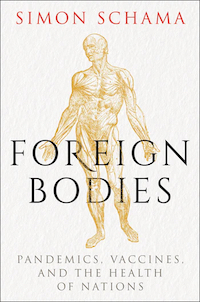Public ideas
Simon Schama on pretty well everything
On last week’s Saturday Extra Geraldine Doogue interviewed Simon Schama in a session titled A history of vaccines in “Foreign Bodies” . His 19-minute interview starts with a message about the power of nature and ends with one about conspiracy theories, connecting the two ideas with historical stories about vaccines.

On the power of nature he reminds us that “in the end all history is natural history”. We may study the doings of kings and emperors, the conduct of wars over territory, the dynamics of ethnic conflicts, but outside human control are earthquakes, asteroids and of course viruses, which can have extraordinary consequences.
He ends with observations about conspiracy theories, which were circulating during the Covid-19 pandemic. Remember those mind-controlling microchips that were injected into your body, having been carried in the Covid-19 vaccinations? Conspiracy theories are comforting because they explain everything. They are fertilized by social media, in a political landscape where there has been “a victory of opinion over knowledge”.
Schama is promoting his book Foreign bodies: pandemics, vaccines, and the health of nations.
Republican virtues
“RoboDebt could not easily happen in the US”, writes former Senator Rex Patrick in Michael West Media: How to make sure RoboDebt could never happen again: ditch Westminster, embrace the republic.
Robodebt was allowed to continue because senior public servants were loyal, not to the public as represented by Parliament, but to executive government.
Officials felt confident they could operate with impunity to oversight by the Parliament, and particularly the Senate. So long as they responded to senators in a manner that protected ministers and their political interests, the minister protected them back. It was a marriage of convenience and self-interest at the expense of lawful government and the public interest.
He argues for a separation between executive government and the legislature, as exists in the US, where the executive and legislature are entirely separate.
One may respond that the US has too much separation of powers, and so much scope for political interference in appointments, that we would be unwise to import such a structure. Patrick acknowledges faults in the US system, but:
At the very least we need to exclude ministers from the Senate and make the upper chamber of parliament what it was meant to be – a house of scrutiny and review, able to probe the workings of government without the obstruction it currently encounters regardless of who is in power.
At times there have been suggestions for a stronger separation, requiring senators to resign from political parties, and even disallowing them to run for the House of Representatives in following elections.
Patrick reminds us that Albanese said he wants to hold a referendum in the next term of parliament to create an Australian head of state. Patrick hopes it will be more than the minimalist model proposed in the 1999 referendum.
His main point is about more separation between the executive and the legislature. It is doubtful if anyone with Patrick’s parliamentary experience and record of service would advocate the full US model, where the head of state and the head of government are one and the same. But our present situation, where we have a nominal head of state in a distant foreign country, and a de-facto head of state (the governor-general) effectively appointed by the head of government (the prime minister) is even worse.
Living longer
Martyn Goddard has put together a history of life expectancy in Australia and the world, going back a few hundred thousand years: How long will you live?. Along the way he deals with a few myths, such as the idea that Australians have always enjoyed higher life expectancy than the unfortunate blighters in England and Wales.
His main contribution is to show the huge increase in life expectancy at birth, from around 50 to almost 85 years over the last 100 years. Most, but by no means all of this, is due to a dramatic improvement in child mortality. More of us are also living well beyond 85: Goddard shows the huge growth in the proportion of people in their 80s and 90s.
Those increases in life span appear to be asymptotic, however. That is, they are showing signs of flattening out at about 110.
In terms of public policy these changes will creep up on us, but they can be profound. The need for our society to devote more resources to health care and general care is one obvious issue – possibly overstated if we also manage to live healthier lives. There are many less obvious issues, to do with housing and urban design. And then there are social and political consequences: will there be octogenarians rioting in the streets when a future treasurer tries to lift the retirement age to 85?